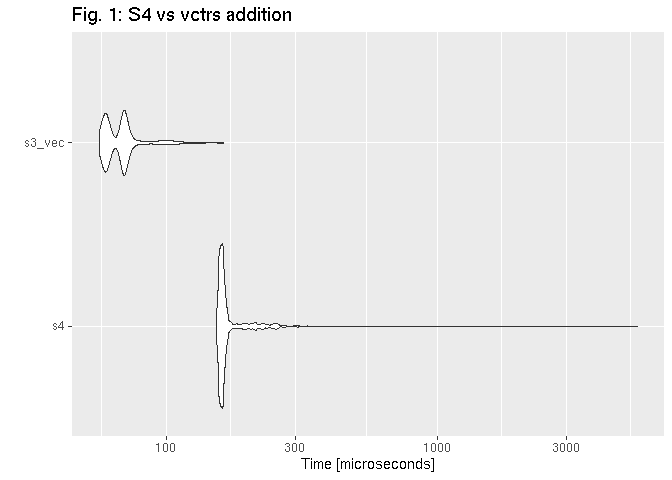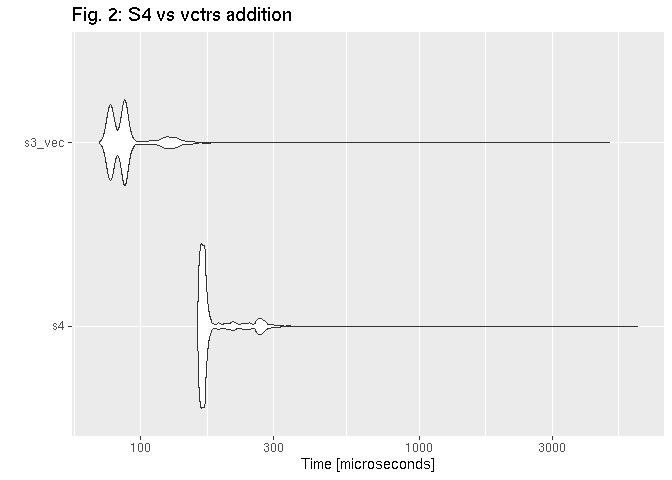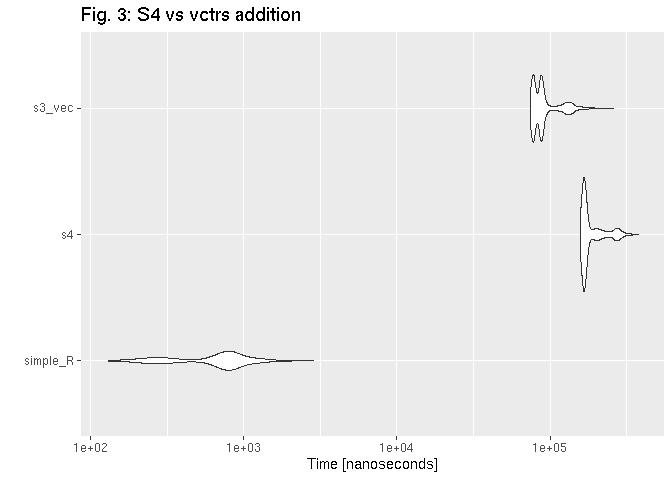Double dispatch in R: S4 vs vctrs
en r vctrs s4Why do we may need double dispatch?
In most cases, when writing R scripts or even creating R packages, it is enough to use standard functions or S3 methods. However, there is one important field that forces us to consider double dispatch question: arithmetic operators.
Suppose we’d like to create a class, which fits the problem we’re currently working on. Let’s name such class beer.
beer <- function(type){
structure(list(type = type),class = "beer")
}
opener <- function(){
structure(list(), class = "opener")
}
pilsner <- beer("pilnser")
my_opener <- opener()
Then, we create an operator which defines some non-standard behaviour.
- if we add an opener to the beer, we get an opened_beer.
- adding a numeric x, we get a case of beers (which even contain a negative number of bees, i.e. our owe…)
- if second argument is different than a or opener or numeric, we get… untouched beer
Let’s demonstrate, how does it work:
`+.beer` <- function(a, b){
if (inherits(b, "opener")) {
return(structure(list(
name = paste("opened", a$name)
), class = "opened_beer"))
} else if (inherits(b, "numeric")) {
print("It's magic! You've got a case of beers!")
return(structure(list(
n_beers = 1 + b
), class = "case_of_beers"))
} else {
return(a)
}
}
pilsner + my_opener
## $name
## [1] "opened "
##
## attr(,"class")
## [1] "opened_beer"
pilsner + -0.1
## [1] "It's magic! You've got a case of beers!"
## $n_beers
## [1] 0.9
##
## attr(,"class")
## [1] "case_of_beers"
Don’t you think, that such operations should be commutative?
my_opener + pilsner
## list()
## attr(,"class")
## [1] "opener"
What did happen here? This is an example of the way the R interpreter
handles arithmetic operator. It was described with details on Hiroaki
Yutani’s
blog.
Briefly speaking, in this particular case R engine matched method to the
second argument (not to the first one), because there is no +.opener
S3 method. What about such trick:
`+.opener` <- function(a, b) b + a
After that, the result is different:
my_opener + pilsner
## Warning: Incompatible methods ("+.opener", "+.beer") for "+"
## Error in my_opener + pilsner: non-numeric argument to binary operator
We crashed our function call. When both objects have the + method
defined and these methods are not the same, R is trying to resolve the
conflict by applying an internal +. It obviously cannot work. This
case could be easily solved using more ‘ifs’ in the +.beer beer
function body. But let’s face a different situation.
-0.1 + pilsner
## [1] -0.1
What a mess! Simple S3 methods are definitely not the best solution when we need the double dispatch.
S4 class: a classic approach
To civilize such code, we can use classic R approach, S4 methods. We’ll start from S4 classes declaration.
.S4_beer <- setClass("S4_beer", representation(type = "character"))
.S4_opened_beer <- setClass("S4_opened_beer", representation(type = "character"))
.S4_opener <- setClass("S4_opener", representation(ID = "numeric"))
.S4_case_of_beers <- setClass("S4_case_of_beers", representation(n_beers = "numeric"))
Then, we can two otptions, how to handle + operators. I didn’t mention
about it in the previous example, but both S3 and S4 operators are
grouped as so-called group generic functions (learn more:
S3,
S4).
We can set a S4 method for a single operator and that looks as follows:
setMethod("+", c(e1 = "S4_beer", e2 = "S4_opener"),
function(e1, e2){
if (inherits(e2, "S4_opener")) {
return(.S4_opened_beer(type = paste("opened", e1@type)))
} else if (inherits(e2, "numeric")) {
print("It's magic! You've got a case of beers!")
return(.S4_case_of_beers(n_beers = 1 + e2))
} else {
return(e1)
}
})
setMethod("+", c(e1 = "S4_opener", e2 = "S4_beer"),
function(e1, e2) e2 + e1)
Alternatively, we can define a method for Arith geneneric and check,
what method is exactly called at the moment. I decided to use the second
approach, because it’s more similar to the way the double dispatch is
implemented in the vctrs library.
.S4_fun <- function(e1, e2){
if (inherits(e2, "S4_opener")) {
return(.S4_opened_beer(type = paste("opened", e1@type)))
} else if (inherits(e2, "numeric")) {
print("It's magic! You've got a case of beers!")
return(.S4_case_of_beers(n_beers = 1 + e2))
} else {
return(e1)
}
}
setMethod("Arith", c(e1 = "S4_beer", e2 = "S4_opener"),
function(e1, e2)
{
op = .Generic[[1]]
switch(op,
`+` = .S4_fun(e1, e2),
stop("undefined operation")
)
})
setMethod("Arith", c(e1="S4_opener", e2="S4_beer"),
function(e1, e2)
{
op = .Generic[[1]]
switch(op,
`+` = e2 + e1,
stop("undefined operation")
)
})
Let’s create our class instances and do a piece of math.
S4_pilsner <- .S4_beer(type = "Pilsner")
S4_opener <- .S4_opener(ID = 1)
S4_pilsner + S4_opener
## An object of class "S4_opened_beer"
## Slot "type":
## [1] "opened Pilsner"
S4_opener + S4_pilsner
## An object of class "S4_opened_beer"
## Slot "type":
## [1] "opened Pilsner"
Declared methods are clear, and, the most important: they work correctly.
vctrs library: a tidyverse approach
vctrs is an interesting library, thought as a remedy for a couple of R disadvantages. It delivers, among others, a custom double-dispatch system based on well-known S3 mechanism.
At the first step we declare class ‘constructors’.
library(vctrs)
.vec_beer <- function(type){
new_vctr(.data = list(type = type), class = "vec_beer")
}
.vec_opened_beer <- function(type){
new_vctr(.data = list(type = type), class = "vec_opened_beer")
}
.vec_case_of_beers <- function(n_beers){
new_vctr(.data = list(n_beers = n_beers), class = "vec_case_of_beers")
}
.vec_opener <- function(){
new_vctr(.data = list(), class = "vec_opener")
}
Then, we create class instances.
vec_pilsner <- .vec_beer("pilnser")
vec_opener <- .vec_opener()
print(class(vec_pilsner))
## [1] "vec_beer" "vctrs_vctr"
print(class(vec_opener))
## [1] "vec_opener" "vctrs_vctr"
At the end, we write a double-dispatched methods in vctrs style. As you can see,
.fun <- function(a, b){
if (inherits(b, "vec_opener")) {
return(.vec_opened_beer(type = paste("opened", a$type)))
} else if (inherits(b, "numeric")) {
print("It's magic! You've got a case of beers!")
return(.vec_case_of_beers(n_beers = 1 + b))
} else {
return(a)
}
}
vec_arith.vec_beer <- function(op, x, y, ...) {
UseMethod("vec_arith.vec_beer", y)
}
vec_arith.vec_opener <- function(op, x, y, ...) {
UseMethod("vec_arith.vec_opener", y)
}
vec_arith.vec_beer.vec_opener <- function(op, x, y, ...){
switch(op,
`+` = .fun(x, y),
stop_incompatible_op(op, x, y)
)
}
vec_arith.vec_opener.vec_beer <- function(op, x, y, ...){
y + x
}
vec_pilsner + vec_opener
## <vec_opened_beer[1]>
## type
## opened pilnser
vec_opener + vec_pilsner
## <vec_opened_beer[1]>
## type
## opened pilnser
It works properly, too.
Benchmark
I’ve created all the classes and methods above not only to demonstate, how to implement double dispatch in R. My main goal is to benchmark both approaches and check, which one has smaller overhead. The hardware I used for the test looks as follows:
## $vendor_id
## [1] "GenuineIntel"
##
## $model_name
## [1] "Intel(R) Core(TM) i3 CPU M 350 @ 2.27GHz"
##
## $no_of_cores
## [1] 4
## 8.19 GB
sessionInfo()
## R version 3.6.1 (2019-07-05)
## Platform: x86_64-pc-linux-gnu (64-bit)
## Running under: Ubuntu 18.04.2 LTS
##
## Matrix products: default
## BLAS: /usr/local/lib/R/lib/libRblas.so
## LAPACK: /usr/local/lib/R/lib/libRlapack.so
##
## locale:
## [1] LC_CTYPE=pl_PL.UTF-8 LC_NUMERIC=C
## [3] LC_TIME=pl_PL.UTF-8 LC_COLLATE=pl_PL.UTF-8
## [5] LC_MONETARY=pl_PL.UTF-8 LC_MESSAGES=en_US.utf8
## [7] LC_PAPER=pl_PL.UTF-8 LC_NAME=C
## [9] LC_ADDRESS=C LC_TELEPHONE=C
## [11] LC_MEASUREMENT=pl_PL.UTF-8 LC_IDENTIFICATION=C
##
## attached base packages:
## [1] stats graphics grDevices utils datasets methods base
##
## other attached packages:
## [1] vctrs_0.2.3
##
## loaded via a namespace (and not attached):
## [1] Rcpp_1.0.3 benchmarkmeData_1.0.3 knitr_1.23
## [4] magrittr_1.5 tidyselect_0.2.5 doParallel_1.0.15
## [7] lattice_0.20-38 R6_2.4.0 rlang_0.4.2
## [10] foreach_1.4.7 httr_1.4.1 stringr_1.4.0
## [13] dplyr_0.8.3 tools_3.6.1 parallel_3.6.1
## [16] grid_3.6.1 xfun_0.9 htmltools_0.3.6
## [19] iterators_1.0.12 yaml_2.2.0 digest_0.6.25
## [22] assertthat_0.2.1 tibble_2.1.3 benchmarkme_1.0.3
## [25] crayon_1.3.4 Matrix_1.2-17 purrr_0.3.3
## [28] codetools_0.2-16 glue_1.3.1 evaluate_0.14
## [31] rmarkdown_1.14 stringi_1.4.3 pillar_1.4.2
## [34] compiler_3.6.1 pkgconfig_2.0.2
It’s my good old notebook, which is not a beast.
library(microbenchmark)
library(ggplot2)
Beer + opener
bm1 <- microbenchmark(
s4 = S4_pilsner + S4_opener,
s3_vec = vec_pilsner + vec_opener,
times = 1000
)
## Unit: microseconds
## expr min lq mean median uq max neval
## s4 153.292 158.2120 178.40541 161.4225 165.6375 5506.681 1000
## s3_vec 56.686 60.1265 69.52364 68.9240 70.8830 163.278 1000

Opener + beer
bm2 <- microbenchmark(
s4 = S4_opener + S4_pilsner,
s3_vec = vec_opener + vec_pilsner,
times = 1000
)
## Unit: microseconds
## expr min lq mean median uq max neval
## s4 159.512 164.6735 191.74781 168.9655 176.3165 6068.477 1000
## s3_vec 71.110 78.5835 96.22535 86.6720 89.4015 4796.377 1000

Bonus: opener + beer vs addtion of numerics
bm3 <- microbenchmark(
simple_R = 1 + 2,
s4 = S4_opener + S4_pilsner,
s3_vec = vec_opener + vec_pilsner,
times = 1000
)
## Unit: nanoseconds
## expr min lq mean median uq max neval
## simple_R 130 344.0 697.49 744.5 857 2862 1000
## s4 158769 164522.5 189297.35 169270.5 198120 375648 1000
## s3_vec 74775 78395.5 94786.28 87192.5 94085 258129 1000

Conclusions
It seems that vctrs-based performs better than traditional S4 methods. Obviously, I checked only one operation and probably some edge cases may exists. However, I think that it shows us some direction, what execution time we can expect.
Further sources
If you are interesting, how to implement double-dispatched operators in S4, I encourage you to get familiar with code of the following R libraries:
If you are looking for some examples of vctrs, I recommend you to learn the source code of:
